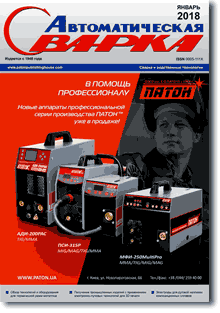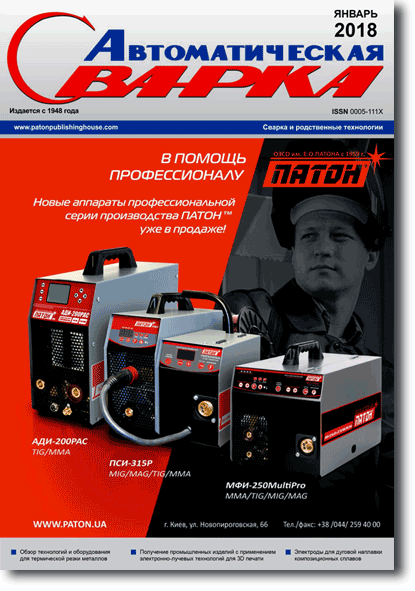| 2018 №01 (03) |
DOI of Article 10.15407/as2018.01.04 |
2018 №01 (05) |

Avtomaticheskaya Svarka (Automatic Welding), #1, 2018, pp. 29-33
Stress-strain state of welded joints from aluminium alloys under the conditions simulating open space
E.A. Asnis, E.G. Ternovoj, E.A. Velikoivanenko, A.S. Milenin and G.F. Rozynka
E.O. Paton Electric Welding Institute of the NAS of Ukraine 11 Kazimir Malevich Str., 03150, Kyiv, Ukraine. E-mail: office@paton.kiev.ua
Abstract
The paper gives the results of computational research of the influence of light-shade boundaries promoting preheating of joints of sunlit plates to be welded and their intensive cooling on the shaded side during electron beam welding under the conditions simulating open space, on the stress-strain state. A set of numerical procedures and software for computer modeling of the kinetics of temperature fields, stresses and strains in butt fusion welding of plates from aluminium alloy AMg6, allowing for essentially non-uniform external temperature impact were developed for this purpose. The influence of the position of light-shade boundaries relative to the weld on the forming instantaneous and residual stressed state of aluminium plates in welding was analyzed. For this purpose the respective problems of nonstationary thermoplasticity were solved by finite element method, based on computational temperature field kinetics, determined allowing for the features of the impact of welding heat source and conditions of external heating and cooling. Performed calculations showed, in particular, that distribution of residual stresses forming in welded joints of plates from aluminium alloy AMg6 at different position of light-shade boundaries, is characterized by maximum stresses, which do not reach the base metal yield limit (170–180 MPa). Such stresses should not essentially lower the mechanical characteristics and performance of welded parts and components, produced in open space conditions. 6 Ref., 3 Figures.
Keywords: simulation of open space conditions, light-shade boundary, stressed state, mathematical modeling
Received: 20.11.17
Published: 15.02.18
References
- Paton, B.E. (2000) Space: technologies, materials science, structures. Kiev, PWI [in Russian].
- Fragomeni, J.M., Nunes Jr., A.C. (2003) A study of the effects of welding parameters on electron beam welding in the space environment. Aerospace Sci. and Technology, 7, 373–384. https://doi.org/10.1016/S1270-9638(03)00031-2
- Rabkin, D.M. (1986) Metallurgy of welding of aluminium alloys. Kiev, Naukova Dumka [in Russian].
- Bondarev, A.A., Ternovoj, E.G. (2010) Features of weld formation and properties of aluminium and magnesium alloy joints under simulated space conditions. The Paton Welding J., 11, 16–20.
- Makhnenko, V.I. (2006) Resource of safe operation of welded joints and assemblies of modern structures. Kiev, Naukova Dumka [in Russian].
- Mi, G., Li, C., Gao, Z. et al. (2014) Finite element analysis of welding residual stresses of aluminum plates under different butt joint parameters. Engineering Review, 34(3), 161–166.
The cost of subscription/purchase order journals or individual articles
| Journal/Currency | Annual Set | 1 issue printed |
1 issue |
one article |
| TPWJ/USD | 384 $ | 32 $ | 26 $ | 13 $ |
| TPWJ/EUR | 348 € | 29 € | 24 € | 12 € |
| TPWJ/UAH | 7200 UAH | 600 UAH | 600 UAH | 280 UAH |
| AS/UAH | 1800 UAH | 300 UAH | 300 UAH | 150 UAH |
| AS/USD | 192 $ | 32 $ | 26 $ | 13 $ |
| AS/EUR | 180 € | 30 € | 25 € | 12 € |
| SEM/UAH | 1200 UAH | 300 UAH | 300 UAH | 150 UAH |
| SEM/USD | 128 $ | 32 $ | 26 $ | 13 $ |
| SEM/EUR | 120 € | 30 € | 25 € | 12 € |
| TDNK/UAH | 1200 UAH | 300 UAH | 300 UAH | 150 UAH |
| TDNK/USD | 128 $ | 32 $ | 26 $ | 13 $ |
| TDNK/EUR | 120 € | 30 € | 25 € | 15 € |
AS = «Automatic Welding» - 6 issues per year;
TPWJ = «PATON WELDING JOURNAL» - 12 issues per year;
SEM = «Electrometallurgy Today» - 4 issues per year;
TDNK = «Technical Diagnostics and Non-Destructive Testing» - 4 issues per year.





